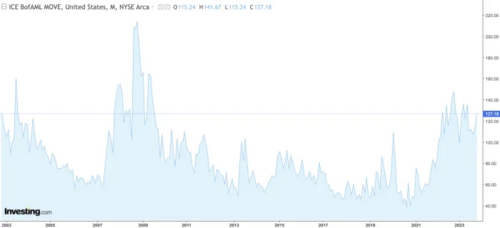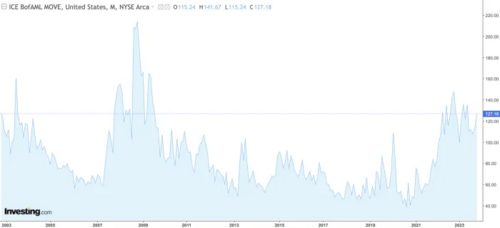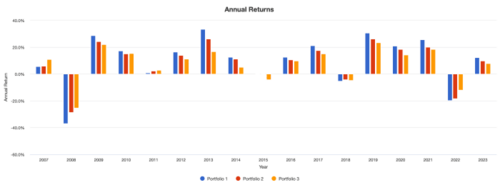
Gold is a better diversifier when bonds are this correlated to stocks – TheStreet's Dierking
Get all the essential market news and expert opinions in one place with our daily newsletter. Receive a comprehensive recap of the day's top stories directly to your inbox. Sign up here!
Bonds are no longer a very good diversifier as they have become too correlated with equities, making gold and other commodities a superior choice, according to David Dierking, Editor of ETF Focus at TheStreet.
Dierking noted that investors who stuck with the classic 60/40 portfolio over the past couple of years have suffered, as “only a 100/0 portfolio really had a chance at generating positive returns.” And while 5% yields on Treasury bills have looked very attractive recently, long-term Treasury bonds are down 45% from their 2020 peak.
“As the Fed has executed the most aggressive rate hiking cycle in history, it’s lifted bond market volatility to historically high levels,” he said.

Dierking points out that the last time the bond market was this volatile was during the financial crisis, and this volatility has remained elevated for a year and a half. “I probably don’t need to tell you that when market volatility is at 15-year highs and has been that way for the past six quarters, nothing good usually comes of it,” he said.
With inflation still a problem, bond market volatility will likely remain high along with yields, so going heavily into Treasuries and cash isn’t the best move, he said, and investors should consider rotating part of their portfolio into gold and other commodities instead.
“Treasuries have a long history of acting as a great diversifier to stocks (the past two years notwithstanding),” Dierking wrote. “Their low correlation to other riskier asset classes helps to reduce overall portfolio risk and smooth out some of the volatility that occurs on a regular basis in the financial markets.”
But he said gold and commodities do the same thing, perhaps even better. “Gold has virtually no correlation at all to stocks, making it perhaps the ultimate diversifier,” he said. “Commodities also have a low correlation to stocks, but their price movements are often based more heavily on where we are in the market cycle.”
Dierking shows the relative performance of stocks, bonds, gold and commodities over the past 15 years.

“The historical absolute returns of each asset class aren’t what’s important here since the future is likely to look very different,” he said. “What’s much less likely to change are risk levels and inter-asset correlations. Equity correlation to both bonds and gold, historically, have been very low and the correlation to commodities, while higher, is still at the level where there is significant diversification benefits.”
Dierking wrote that the problem is that stocks and bonds are much more correlated today than in the past, perhaps as high as 0.80. “Plus, when that high correlation is associated with downside risk, it makes the portfolio construction decision that much more complicated,” he said. “While the stock/bond correlation is likely to return to the long-term average eventually, but the short-term solution may be to substitute the temporarily high correlation of bonds for the low correlation of gold and commodities.”
To test this, Dierking created three simulated portfolios: Portfolio #1 holds 100% U.S. Stock Market, Portfolio #2 is 80% U.S. Stock Market and 20% U.S. Bond Market, and Portfolio #3 contains 60% U.S. Stock Market, 20% U.S. Bond Market, 10% Gold, and 10% Commodities.
“You may ask why I would take the 20% away from stocks in Portfolio #3 instead of bonds,” he said. “The answer is that I believe we will soon enter a period where safe haven assets begin behaving like safe haven assets again. That likely comes with the onset of a potential recession in the next couple of quarters. If that happens, the higher return potential will be with bonds, not stocks.”
Dierking then back tests the three portfolios over the past 16 years.

“The all-stock portfolio produced better returns on an absolute basis than did the more diversified portfolios, but it also came with much more risk,” he noted. “The 60/20/10/10 portfolio lagged the 100/0 portfolio by about 2% annually, but it was also about 30% less volatile. Its maximum drawdown over the measurement period was also only about 2/3 of the all-stock portfolio.”
Dierking said that the most interesting finding was the comparative risk-adjusted returns. “The Sharpe and Sortino ratios for the 100/0 and 60/20/10/10 portfolios are virtually identical, which means that they’ve delivered the same amount of return for each unit of risk,” he said. “The more diversified portfolio just dials things back by about 30%.”
He added that this remains true when annual returns are analyzed. “There’s a very consistent pattern (with just a few outliers) where the gain/loss on the 60/20/10/10 portfolio is less than that of the other two,” he said.

Dierking wrote that while investors are always looking for ways to maximize returns, most don’t realize that they can get those returns while minimizing downside risk. “Losing less is just as valuable as gaining more,” he said. “If we are indeed trending towards a recessionary environment, the lower risk factor of the 60/20/10/10 portfolio could be incredibly valuable.”
By
Ernest Hoffman
For Kitco News
Tim Moseley
